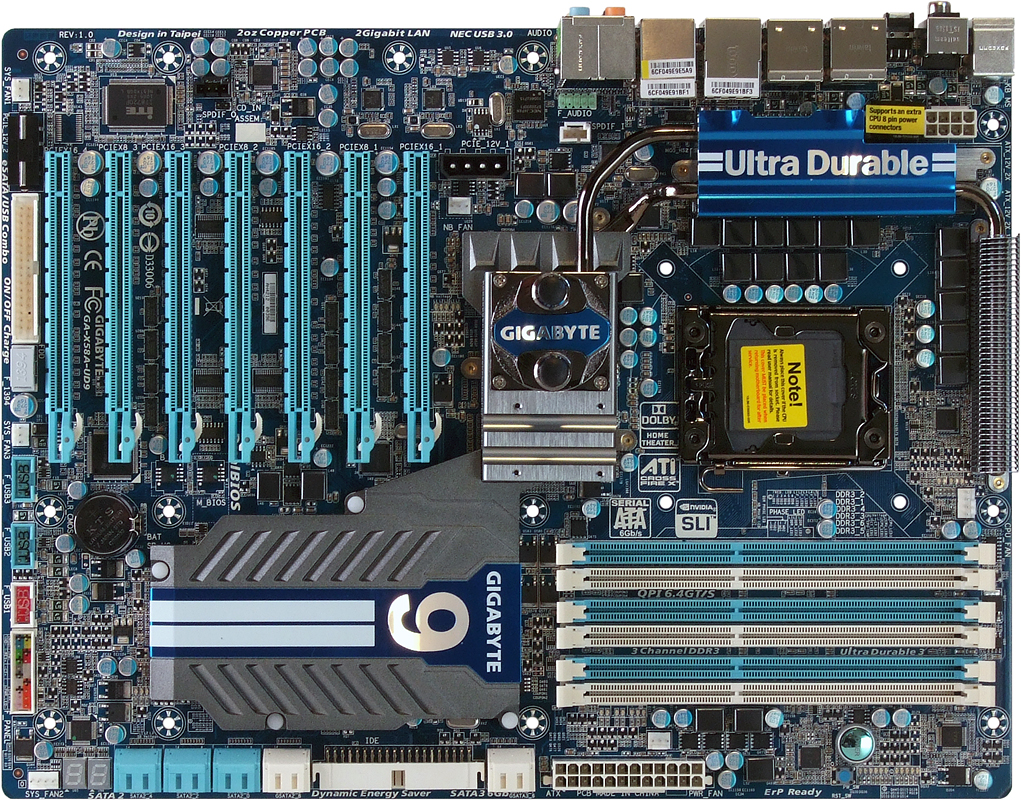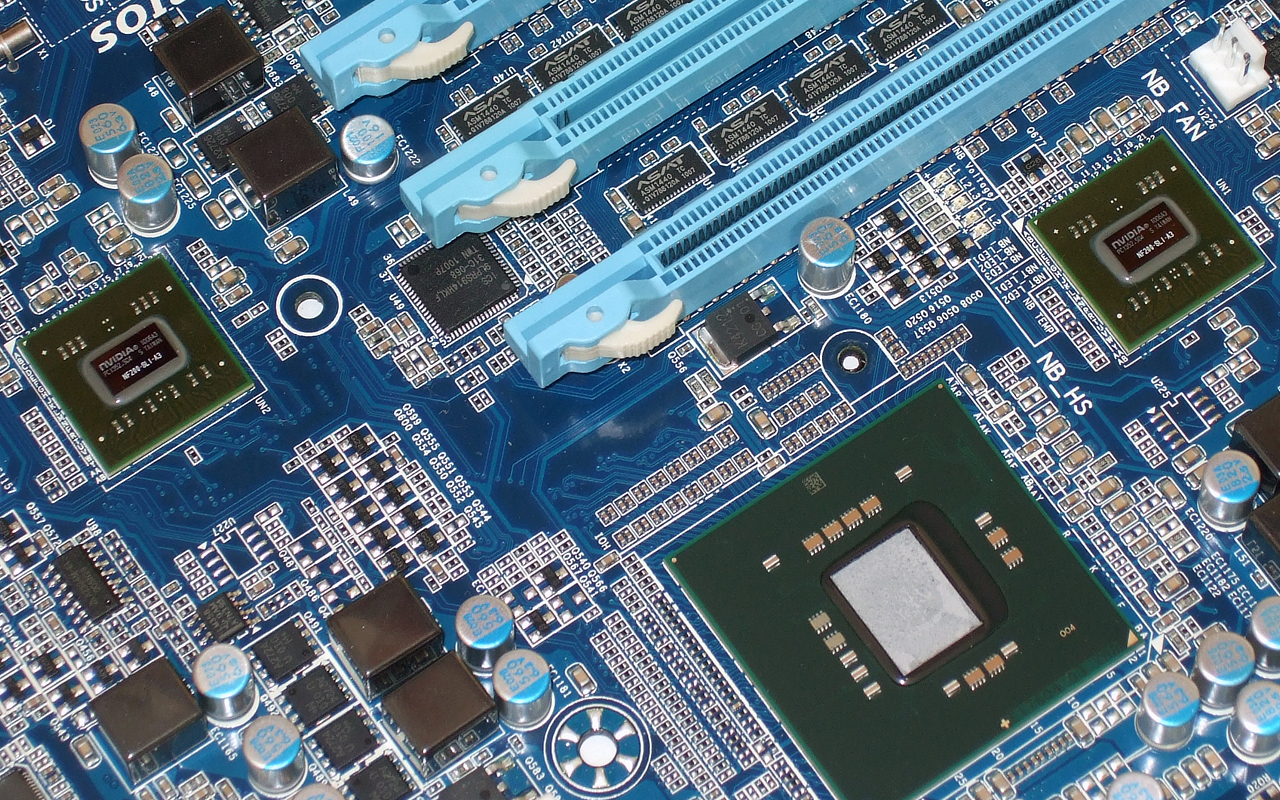X58 To The Max: Three New Flagship LGA 1366 Motherboards
Supporting Intel’s highest-performance processors with twice the bandwidth of its mainstream counterpart, the X58 chipset proves the staying power of good ideas. We take a closer look at what makes the latest generation of premium motherboards special.
Gigabyte GA-X58A-UD9
Gigabyte thinks it has the perfect solution for anyone who can’t be satisfied by ordinary Quad-SLI or four-way CrossFireX graphics configurations. Its X58A-UD9 supports a total of seven single-slot graphics cards or up to four two-slot cards at uncompromised bandwidth.
Buyers still get all the features they’ve come to expect from Gigabyte’s high-end boards, including three additional SATA controllers, dual-gigabit networking, triple IEEE-1394 FireWire ports, and enhanced chipset cooling. One of those drive controllers has two SATA 6Gb/s ports, and Gigabyte also throws in a USB 3.0 controller for two of the board’s I/O panel ports. Gigabyte’s Hybrid Silent-Pipe 2 chipset cooler includes a northbridge sink with an integrated 3/8” tube water block and a bolt-on, slot-mounted heat sink.
Fitting seven expansion slots on an ordinary ATX motherboard wouldn’t have been a problem, but a cooling solution that consumes two slot places extends the X58A-UD9 to a nine-place design. There is no sanctioned standard for extra-long boards in spite of labels various companies have tried to use, while the EATX label (which is commonly misused) applies to boards that are wider but not longer than ATX. The X58A-UD9 easily fits into one of several 10-slot cases that follow Foxconn’s Ultra ATX proposal of 2008. The tenth slot of such cases is perfect for holding a two-slot graphics card in the X58A-UD9’s bottom slot.
As with most of its competitors, putting a two-space graphics card in the bottom slot usually requires smashing the front-panel cables flat, a nuisance that spoils what might otherwise be an excellent front-panel connector layout. That’s often not as big a problem for the right-angle connectors of legacy floppy cables, but anyone who needs this relic of Windows XP’s F6 prompt will still be disappointed to see it located so far away from the front panel bays where these outdated drives fit.
Other points of interest include power and reset buttons near the top of the front edge, a two-digit Port 80 diagnostics display near the bottom of the front edge, and a second eight-pin CPU power connector (covered by a yellow sticker in the above photo) that feeds the X58A-UD9’s 24-phase power regulator.
The X58A-UD9 alternates four true x16 slots with three eight-lane slots, where populating an eight-lane slot forces it to borrow half of the lanes from the slot above it. Four-card configurations get a full 16 lanes per card, while only the seventh card gets full bandwidth when all seven slots are filled. That still accounts for nearly twice as many PCIe lanes compared to what the X58 northbridge offers, which is a technological wonder brought about through the use of two NF200 PCIe bridges.
One often-overlooked feature that Gigabyte wants everyone to remember is that two of its front-panel USB ports support its “3x USB Power” and “USB On/Off” circuit design for charging high-current USB devices, such as the Apple iPad, even from standby power when the system is off.
Get Tom's Hardware's best news and in-depth reviews, straight to your inbox.
As the only board in today’s comparison to include the important four-way SLI bridge, the X58A-UD9 still falls a little short in its cable set by having only four SATA cables on a board that supports 10 internal drives. Less-elaborate graphics configurations are possible from the included two- and three-way SLI bridges, while adding the pair of included CrossFire bridges to one that came with a card would make four-way CrossFireX possible.
Current page: Gigabyte GA-X58A-UD9
Prev Page Rampage III Extreme Utilities Next Page GA-X58A-UD9 BIOS-
one-shot No EVGA SR-2? :(Reply
Ok, Hold on. Three Flagship LGA 1366 Boards and no overclocked power consumption results? These boards are obviously made for overclocking and those results would be very interesting to see. -
Lmeow Reply9498281 said:No EVGA SR-2? :(
The EVGA Classified SR-2 is based on the Intel 5520 chipset and uses Xeons, so it's not an X58 board technically speaking which is why it doesn't qualify. ;)
If I could spend that much on a motherboard I'd have chosen the Rampage III Extreme, not only does it have good features it also has the best colour scheme. ^^
Does anyone know why I try to submit a comment it doesn't show up, and I have to use the forums instead to post a comment instead? -
sudeshc I am totally impressed by ASUS they always come up with best solution in every category, but the price is a killer for me :(Reply
-
rottingsheep IMO, the only interesting part about motherboard reviews is the overclocking and power consumption portion.Reply -
avatar_raq Nice article..I have only catch: Of all the mobos tested, Quad SLI is not possible on the ASUS R3E, courtesy of nVIDIA's driversReply
http://www.guru3d.com/news/quad-sli-on-asus-rampage-iii-extreme-is-not-possible/ -
dragonfang18 Whats the point when Intel will come out with new processors with different sockets next year?Reply -
Crashman avatar_raqNice article..I have only catch: Of all the mobos tested, Quad SLI is not possible on the ASUS R3E, courtesy of nVIDIA's drivershttp://www.guru3d.com/news/quad-sl -possible/Awesome, thanks. Manufacturers don't actually discuss this stuff.Reply
dragonfang18Whats the point when Intel will come out with new processors with different sockets next year?That's what people like you were saying months before LGA 1156 was released. We see which direction that went. -
dragonfang18 ReplyThat's what people like you were saying months before LGA 1156 was released. We see which direction that went.
Yeah... they are changing 1366 to some socket R... Well... At least I can look forward to these motherboards going down in price by next year when they go to Socket R's for performance than 1366's. I guess ill be happy with 1366's. Hopefully they go down by at least $100.





